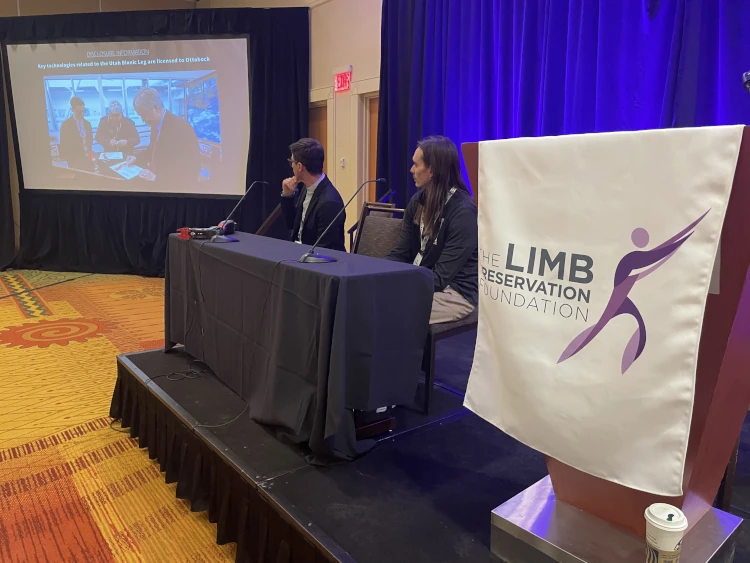
The theme of last Friday’s 2nd Annual Limb Preservation Foundation Symposium (co-sponsored by Amplitude) was “Hope, Help & Possibilities.” It was hard not to feel hopeful after the day-long event, which showcased the bounty of emerging treatments and technologies to improve amputees’ lives. There were sessions on mobility, mental health, pain management, osseointegration, next-gen bionic limbs, and a whole lot more.
Here’s a handful of highlights that made our spirits soar. Read them over, then head to LPF’s Learning Lab to find links to all the presentations in their entirety. And it’s not too late to make a donation in support of LPF, which supports people year-round with peer support, education, scholarships, and other programs.
There’s no health without mental health.
There was a session directly focused on mental and emotional health, but the subject kept coming up in all the sessions. Also in the exhibit hall, around the dinner table, and in the hotel corridors. For example, when we moderated a session about osseointegration, Gini Thomas told us how OI eliminated her anxiety about sweating out of her socket—a routine summertime occurrence in Alabama, where Thomas lives. Likewise, during a session on innovative bionic limbs, Alec McMorris said the Utah Bionic Leg (which he’s beta testing for the University of Utah’s Bionic Engineering Lab) does more than restore physical function. “It feels like part of my body, part of me,” he said—and that, in turn, improved his overall sense of well-being. Mental health was also front and center during the Gen Y / Gen Z session, where the panelists discussed how society’s misperceptions about limb loss complicate the already-complex process of forming healthy peer relationships, and the emotional energy it takes to overcome those hurdles. Pick any other Symposium presentation—pain management, skin care, rehab—and you’ll find a strong current of mental health content.
Living with limb loss is a team sport.
Humility isn’t usually considered a common trait among surgeons. But both of the nationally renowned osseointegration surgeons on the Symposium’s OI panel—Jason Stoneback (University of Colorado) and Jason Souza (Ohio State)—emphasized that they play a limited part in determining any given patient’s outcome. Souza described OI as “10 percent surgery, 90 percent rehabilitation and prosthetics”; Stoneback, meanwhile, displayed a slide with photos of the 30-plus colleagues who add indispensable value to his work, including prosthetists, PTs, OTs, nurses, prosthetists, radiologists, PM&R specialists, engineers, mental health counselors, and assorted other medical pros. The same theme recurred in nearly every panel: Experts who address a narrow slice of amputee care went out of their way to highlight the multidisciplinary dimensions of their work, teasing out the interconnections between their own field and complementary ones. The takeaway for amputees? Don’t depend on a single health provider. Build a broad-based care team with overlapping and intersecting roles.
Own your outcomes.
Two of our favorite new connections at the Symposium were Brianna Jones and Armeda Batchler. Both traveled from Las Vegas to attend, and they took full advantage of the opportunity to ask questions, look for answers, build personal connections, and gather ideas that can guide their future decisions on all aspects of living with limb loss. Jones and Batchler attended the Symposium in exactly the right spirit. They didn’t just passively receive information—they actively engaged with it, harvesting knowledge that equips them to achieve their own objectives, shape their futures, and call their own shots with confidence. This type of patient self-advocacy is more important than ever in today’s healthcare system.
One success > a thousand failures.
We heard a great story from an attendee who’s in the business of developing new health technologies. This person had been searching high and low for R&D funding to advance a new idea related to limb loss. Fund-hunting is a slog in the best of times; in times like these—post-pandemic, pre-(maybe)-recession—it’s downright brutal. At a particularly discouraging moment during this quest, the individual hopped onto an elevator and found themself shoulder-to-shoulder with a top executive from a major amputee-facing corporation. “My elevator pitch really has not been working,” they thought, “but have I ever tried it while actually riding on elevator?” By the time the doors opened 20 or 30 floors later, the fund-hunter had the executive’s contact info in hand. “It was a ridiculous thing to do,” this person admitted. “Because what were the odds?” But simply by being open to the possibility of success—even in the midst of a painful losing streak—they made a key connection that, over time, culminated in a game-changing investment for their technology.
We like the story for its sheer novelty. But somewhere in there, there’s also a metaphor about staying hopeful about the possibilities of the future, even when the present is bringing you down.